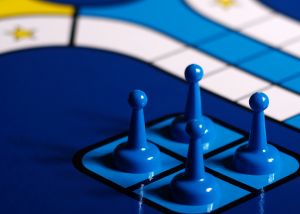
I am sure that in a standard classroom, my daughter would quite happily follow along with the crowd. That’s one of the reasons I’m keeping her out of standard school, actually. However, this would be useful for teachers: everyone else is doing a math activity, so I will too. We’re reading? Oh, ok, I’ll work on that.
In an ideal world, I’d like her to be internally motivated to read, write, and do math. I think that she is, but sometimes it takes some digging. What she’s really motivated to do is pretend play, snuggling, and board games. This means that I work from where she’s at, and if that means doing a lot of pretend play and board games to teach reading, writing, and math, so be it.
Some board games are incredible for teaching literacy and basic math, and they are also so flexible. At age five or six, who cares about using the real rules all of the time?
Dominoes are good for showing one to one correspondence of numbers. Add a domino with a one on it to another domino with a one, and build a domino structure all over the floor. For the longest time I thought that dominoes were for knocking over – apparently they’re actually a math game.
We have a simple game called Bus Stop that involves moving passengers on and off a bus in response to numbers on the dice. It doesn’t sound too exciting, but apparently it’s thrilling to five-year-olds who like to take the bus. It’s also excellent for teaching the general concept of addition and subtraction.
We use a version of Memory or Concentration to teach Dolch words, the most common words in the English language. My daughter has a very good visual memory, so she enjoys beating me at Memory. We say each word as we turn it over.
Do you use board games as teaching tools?

